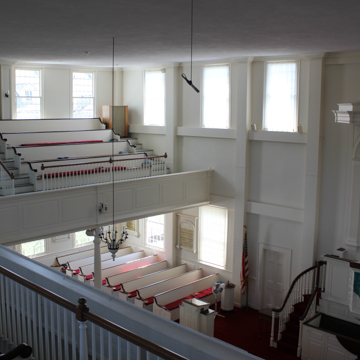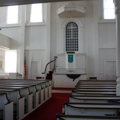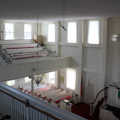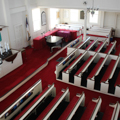First Church of Christ, Congregational, 1652
Farmington Congregation Meeting House, a pre-Revolution Congregational church, is significant for its historic architecture and for its role in the landmark case of the Amistad group, a multifamily group of Africans who were freed by the U.S. Supreme Court in 1841. Today, the meetinghouse is known as the First Church of Christ, Congregational, 1652, named for the founding of the congregation, which has existed to the present day in Farmington under the leadership of twenty successive ministers. The endurance of the parish and of the building are intertwined, each flourishing due to the other throughout their long history.
The congregation's first minister, the Reverend Roger Newton, was the son-in-law of Thomas Hooker, founder of Connecticut, and Newton was succeeded by the Reverend Samuel Hooker, Hooker’s younger son. This connection to the Puritan leader, Thomas Hooker, set the tone for the meetinghouse’s early congregation: strict and solemn. Until 1818, citizens in Connecticut were required to pay taxes to their town’s Congregational church. Although taxation was required, belief and attendance at church were not. Nevertheless, in front of the meetinghouse stands a painted whipping post—a threat to those who failed to attend Sunday services. At the time of its construction, the building, like all Congregational churches in Connecticut, served as both church and town hall. Town matters were intertwined with the church; the words church and meetinghouse were interchangeable. Prior to 1818, meetinghouses were of primary importance to towns, and the attention paid to their architecture reflected this.
In 1672, the first meetinghouse in Farmington was completed. It was a small wooden building but sufficient to meet the needs of the growing community. The second meetinghouse, completed in 1709, was only slightly more elaborate than its predecessor, as utility trumped style for these early iterations. In 1771, construction on the third and final meetinghouse in Farmington began. Captain Judah Woodruff was the architect-builder behind the design. Woodruff, who had built ten houses in the town and was respected for his taste and craftsmanship, was of a class of architect-builders that predated professional architects in America. They relied to a large extent on design books such as James Gibbs’s Book of Architecture (1728), which contained plans and elevations for buildings in styles of the time.
The Farmington meetinghouse is one of the few remaining with its particular plan orientation in Connecticut. The main entrance is in the middle of the western side, and opens into the audience room. This orientation was, for a time, the dominant style, predating the work of Charles Bulfinch, a Boston-born architect of the late eighteenth century noted for reorienting plans of churches. Bulfinch’s long naves with the entrance on the short side recall classical forms. The orientation of Farmington’s meetinghouse is more domestic in nature, due to the residential building experience of many architect-builders and the building’s purpose as a town hall. Opposite the entrance door is the pulpit carved by Woodruff with a charming leaf design on the podium. Another stylistic marker of this particular period of transition is the bell tower. In pre-Revolution times, bell towers typically rose from the ground and seemed to stand adjacent to the primary mass. Later on, towers were integrated into the church building, as in the South Canaan Congregational Church. The Farmington building was completed and the first service held on November, 25, 1772. The preservation of this plan type and bell tower placement makes the integrity of the building particularly valuable.
In the nineteenth century, Farmington Congregation Meeting House played a pivotal role in the landmark case of the Amistad group, Africans freed by the Supreme Court following a rebellion on the high seas. In 1839, Jose Ruiz and Pedro Montez purchased forty-nine people from Mendiland, Africa, and brought them aboard the slaveship Amistad. On the fourth day at sea, two of the captives, Cinque and Grabeau, led a successful mutiny. The ship’s captain and cook were murdered; Ruiz and Montez were held as prisoners and made to assist in navigating the ship back to Africa. However, Ruiz and Montez changed course, and after several weeks of tumultuous sailing the Amistad dropped anchor in Long Island Sound. The group of Africans were taken to Hartford for trial, facing charges of murder, mutiny, and piracy. At the trial, the group became a symbol of political issues—in this case, President Martin Van Buren’s reelection. Van Buren sought to appease Spain and to mollify pro-slavery Southern voters by extraditing the Africans to Cuba. Despite Van Buren’s executive order, the court found in favor of the Africans and ordered the U.S. government to return them to Africa. The U.S. government appealed to the Supreme Court and the Amistad case was argued in February 1841. Former president John Quincy Adams served on the defense. The Supreme Court upheld the lower court’s decision that the Africans should be sent back to their homeland and went so far as to declare them to be free. The group was then transported to Farmington to await their passage home. Van Buren lost the 1841 election, and newspapers reported that the Amistad affair was a factor in his defeat—the use of executive order was seen as an arrogant overstep and slavery became, for the first time, a major political issue for American voters.
From March to November 1841, members of the Congregational church provided housing for the thirty-six surviving members of the Amistad group (as they were now known); while awaiting passage home, the Africans became active in community affairs, converted to Christianity, and attended services at the church. The Amistad affair is the foremost case involving the foreign slave trade in the antebellum era, and became a landmark example for the cause of abolitionists. The case legally established that Africans could be free people—as opposed to slaves—on American soil, upholding the rights of a kidnapped free individual. The role of Farmington Congregation Meeting House in the Amistad affair was as backdrop for a significant shift in American culture.
Today, Farmington Congregation Meeting House continues to operate as a Congregational church. The building’s architecture and its role in history are celebrated and preserved by the parish, and the Amistad story is seen as a pivotal moment in the church’s history.
References
Buggeln, Gretchen. Temples of Grace: The Material Transformation of Connecticut’s Churches, 1790–1840. Lebanon, NH: University Press of New England, 2003.
Kelly, Betty, and Loftus Jestin, eds. A Church in Time: The First Church of Christ, 1652, Farmington, Connecticut within the Context of World History. Farmington: First Church of Christ, 2006.
Kelly, J. Frederick. Early Connecticut Meetinghouses. New York: Columbia University Press, 1948.
Leavenworth, Jesse. “Churches Were the Pillars around Which State’s Towns were Built.” Hartford Courant, August 3, 2014.
Martin, Christopher. The Amistad Affair. London and New York: Abelard-Schuman, 1970.
Waite, Ken, Director of Financing, Farmington Congregational Church, interview by author, Farmington, 30 July 2019.
Writing Credits
If SAH Archipedia has been useful to you, please consider supporting it.
SAH Archipedia tells the story of the United States through its buildings, landscapes, and cities. This freely available resource empowers the public with authoritative knowledge that deepens their understanding and appreciation of the built environment. But the Society of Architectural Historians, which created SAH Archipedia with University of Virginia Press, needs your support to maintain the high-caliber research, writing, photography, cartography, editing, design, and programming that make SAH Archipedia a trusted online resource available to all who value the history of place, heritage tourism, and learning.














